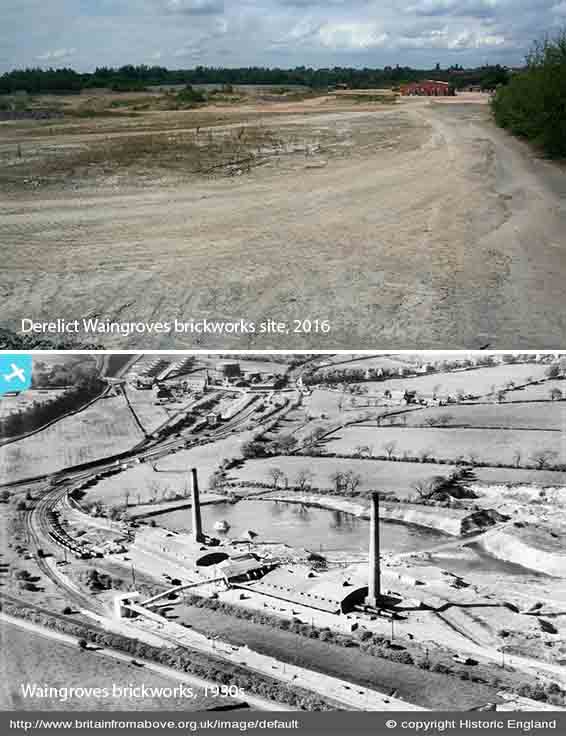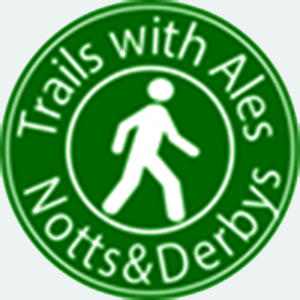
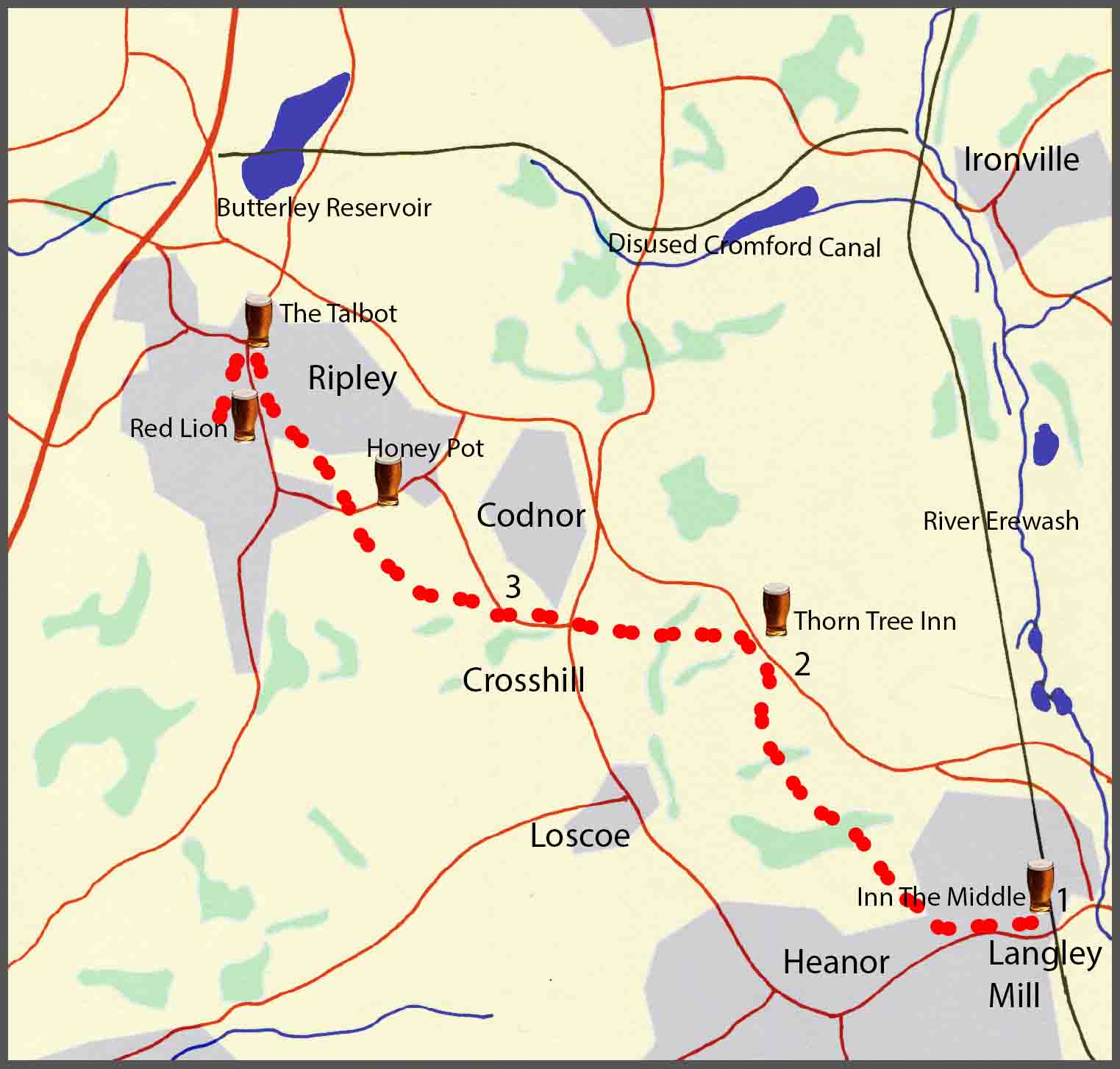
About this walk
The walk described below starts from Langley Mill and passes through Woodlinkin, Crosshill and Waingroves before finishing in Ripley. However, the start and finish points are interchangeable, with good bus services from both Derby and Nottingham.
The overall route covers six miles covering undulating footpaths and bridle ways. There are at least four pubs en-route serving good cask ales. So, at six miles, it’s a comfortable three-pint walk, allowing you to arrive home calorie neutral and none the worse for wear. The pubs include: Inn The Middle at Langley Mill; The Thorntree Inn at Woodlinkin; the Beehive and Honey Pot at Peasehill on the outskirts of Ripley; and the Talbot and the Red Lion at Ripley.
As well as the good ale, there are also along the way a number of points of historical interest. These include: Ormonde Colliery, the Midland Railway’s Butterley to Heanor extension and the old Crosshill and Codnor station, the Butterley Company’s colliery and brickworks at Waingroves.
The route description
1. From the Inn the Middle, walk through Langley Mill along Station Road, in the direction of Heanor, until you reach the traffic lights at the junction with Lower Dunstead Road, not far from the Trent Barton Bus Depot. Just past the junction, on the far side of the Co-op store car park, bear right and take the path that runs alongside the Bailey Brook. Follow the path through a wooded area for about a quarter of a mile after which it opens out with good views across land reclaimed from opencast mining and the slag heaps of Ormonde Colliery. A few hundred yards further on the path leads uphill through more woodland planted as part of the restoration of the opencast mining. At the top of the hill, with open fields now to your right, take the stile on the right that leads across a field to join a farm track where you will bear right to walk uphill. Just under half a mile further along the farm track you will reach the main road, A610, with the Thorntree Inn to the left.
Ormonde was last of the deep-mine pits to be opened in the Heanor area, with shafts sunk by the Butterley Company in 1906, and production beginning in 1908. Following nationalisation in 1947, Ormonde was part of one of the most productive areas of the industry and new machinery was installed to improve output further. In 1952 the first Power Loader machine was installed, followed shortly afterwards by an automatic Trepanner machine. By 1963 Ormonde employed 1219 miners turning out 4200 tones a day. Although by the late 1960s deep mining had finished in the Heanor area except for Ormonde Colliery, a number of pumps at other mines, notably Woodside, had to be kept going to ensure that Ormonde did not flood. This added considerably to the running costs of the pit and Ormonde produced its last coal on 25 September 1970.
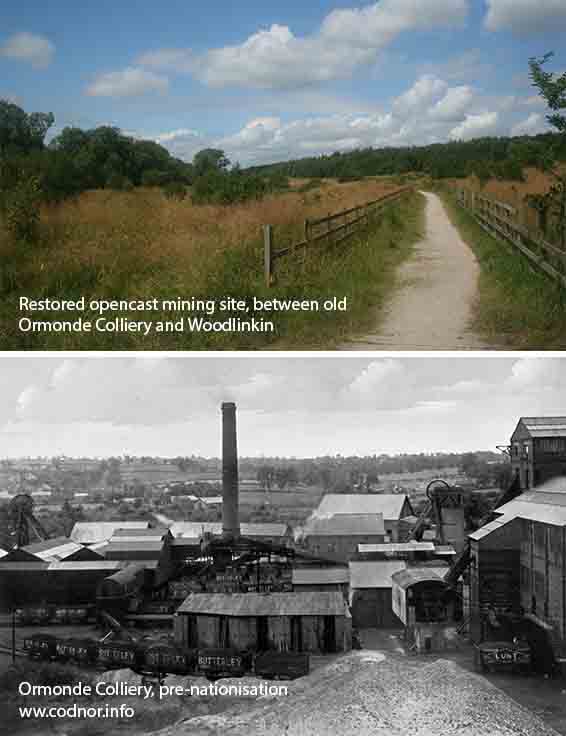
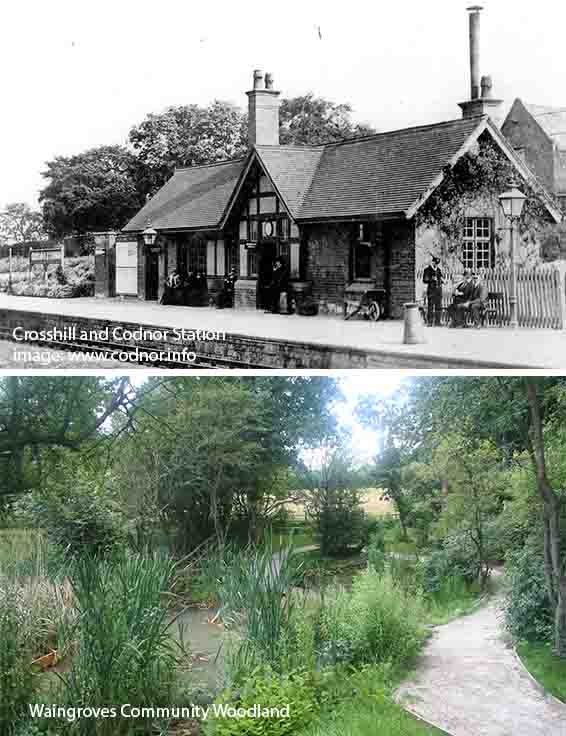
The Crosshill and Codnor railway station was part of the Midland Railway’s extension from Butterley, in Ripley, to Heanor. Although the Ripley and Heanor areas had been well serviced since the mid-1800s by the Midland Railway and the Great Northern Railway, there was no direct railway link between the two towns. Competition between the two companies, and the success of the Great Northern’s Kimberley to Derby extension, prompted the Midland Railway to build the Ripley to Heanor extension in 1890 and, five years later, to continue it to Langley Mill. With the building of the extension, the Midland railway decided to re-locate its Ripley station to the town centre, with the original station, nearly a mile further south-west on Peasehill Road, becoming a goods-only terminus until its closure in 1954. The Crosshill and Codnor station closed in 1926 with the line removed not long after. However, the Ripley station in the centre of town continued operating until 1963 thanks to a separate line that ran south from the town to Little Eaton and Derby.
3. At the bottom of Waingroves Road, before the sharp bend, take the footpath off to the left and, after two hundred yards along the path, take the left turn into the Waingroves Community Woodland, past the old Waingroves pit slag heap, to exit at the top of Pit Lane. Continue approximately two hundred yards down the lane, with the cutting of the old Waingroves pit mineral railway line on your right, then bear right and then left, to take the footpath across the field next to the derelict Butterley brickworks site. At the bottom of the field, take the stile, cross the road, and climb over another stile to re-join the footpath to the Ripley Greenway multi-user track where you will turn right to walk into Ripley. Where the Greenway crosses Peasehill Road, continue on the track for a further three quarters of a mile until you exit at Outram Street. (To reach the Beehive and the Honey Pot, turn right into Peasehill Road and walk along the road for four hundred yards.) At Outram Street, turn left and at the top of the road you will find the Talbot Taphouse. Ripley Town centre and the Red Lion is a short walk from the Talbot.
The brickworks at Waingroves opened in 1890 as a part of the complex of ironworks, limeworks, brickworks and coal mines owned by the Butterley Company of Ripley. The Company closed its pit at Waingroves in 1921 and in the same year installed a new 18 chamber Staffordshire Kiln & chimney at the Waingroves brickworks. This kiln was in use until 1974 and, during its lifetime, it produced 400,000,000 bricks. In 1968, the Butterley Company was taken over by the Wiles Group, later called Hanson plc, which eventually sold off all its engineering interests, just leaving its brick and building materials interests. Waingroves brickworks closed in 2006 and the site is currently derelict awaiting re-development. The Ripley Greenway multi-user track follows the route of the dismantled railway line, originally built by the Midland Railway Company, that connected Ripley to Derby.
